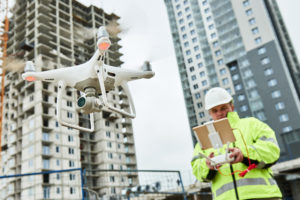
Drones have proven themselves incredibly valuable in the construction industry. In this three part series we will discuss recent changes in FAA regulations, drones’ current and future uses, and how drones could impact mechanics liens.
Before we get ahead of ourselves, it’s probably best to establish exactly what a drone, or small unmanned aircraft, is. The FAA describes a drone as “an unmanned aircraft weighing less than 55 pounds.” Drones vary in level of sophistication, from children’s toys to expensive, hi-tech surveying tools. They have become big business in the United States, and the drone industry is projected to explode in coming years.
From drones getting shot down to drones being used to smuggle drugs into prison, the aircrafts have created some legal issues. Prior regulations were unclear, and the growing popularity of drones led state and local governments to pass their own rules. Several years ago, the FAA finally stepped in with revised regulations. They went into effect on August 29, 2016.
Old FAA Regulations
Using drones for non-hobby or non-recreational purposes has largely been illegal. But no longer! In August 2016, the FAA published new regulations that afford for commercial and government use of drones.
Previously, there were serious restrictions on drone usage. With blanket restrictions, the use of drones for commercial purposes had only been granted on the basis of exceptions and waivers. Drone operation required a different process for licensure, and drones could not be flown within 500 feet of bystanders. Due to the uncertainty of the new technology, over 30 states passed laws regulating drone use. Local and state governments created criminal penalties, drone privacy laws, and laws restricting governmental use. It quickly became clear that uniform regulations were needed.
New FAA Regulations
The FAA’s new regulations for small unmanned aircrafts went into effect in August 2016 and mark a more relaxed approach to drone operation and licensure. Here are of some the pertinent provisions:
- Aircraft must weigh less than 55 lbs
- External loads are allowed if the object being carried is securely attached
- If external load is attached, the total weight, including attached load, must remain less than 55 lb.
- Aircraft must remain in line of sight of operator or a designated observer without using a device or corrective lenses, even if operator is using a first person camera attached to the aircraft
- Aircraft may not operate over persons not directly participating in the operation
- Aircraft may not operate under a covered structure
- Aircraft may only operate in daylight or civil twilight (30 minutes before official sunrise or sunset)
- Maximum groundspeed for aircraft is 100 mph
- Maximum altitude for aircraft is 400 feet above ground level unless within 400 feet of a structure
- Aircraft may not be operated from within a moving vehicle or from within a moving aircraft
- If operation takes place in a sparsely populated area, however, operation from a moving ground vehicle may be acceptable
- Transportation of property for compensation or for hire is allowed (with some restrictions)
- Drones may cross state lines during operation (with some restrictions)
Most restrictions can be waived if the applicant can demonstrate that the operation may be safely conducted under the terms of a certificate of waiver.
Though the new rules are certainly less restrictive, there are still licensing requirements associated with operation of a drone. A drone operator must hold a remote pilot airman certificate with a small Unmanned Aircraft System (UAS) rating or be under the supervision of someone who is. In order to attain a remote pilot certificate, an individual must be at least sixteen years old, be vetted by the TSA, and must pass an initial aeronautical knowledge test at an FAA-approved testing center. If the individual holds a part 61 pilot certificate, that might qualify as the aeronautical knowledge requirement. For those interested in more of the specifics regarding FAA regulations, here’s the full summary.
But what does all of this mean for drones in construction?
Using Drones in Construction
Despite unfavorable limitations, some companies have already begun using drones in construction. The new regulations should invite more drone usage to the industry. Potential uses range anywhere from project security to delivering small tools and materials across a job site. In the distant future, some have even theorized that we might see large drones used in favor of cranes. But for now all operation must fall within the regulations discussed above. It appears that the use of drones in construction is inevitable, and exciting new uses are popping up all the time.


